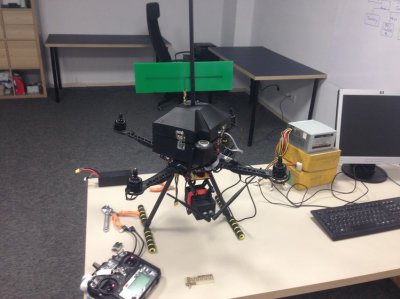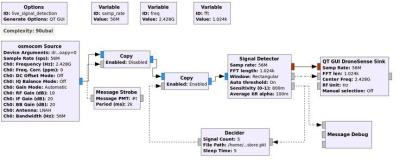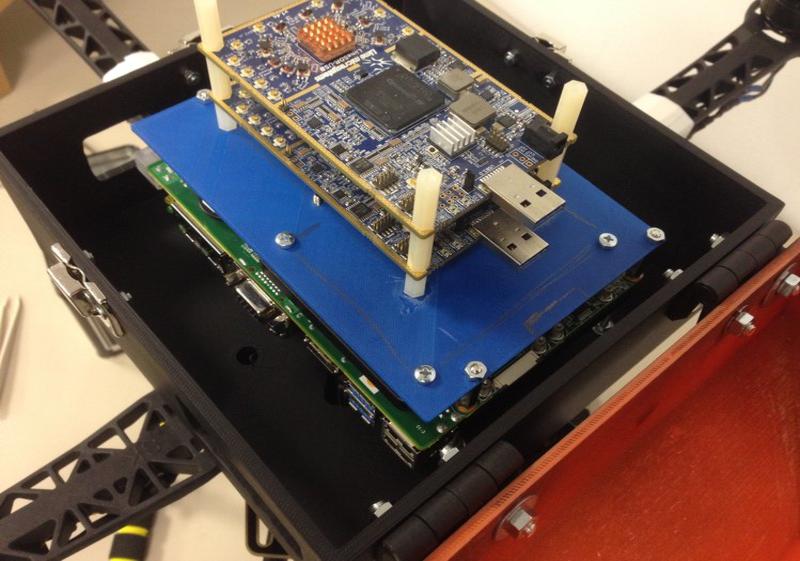After the alleged drone attacks on London Gatwick airport in 2018 we’ve been on the look out for effective countermeasures against these rogue drone operators. An interesting solution has been created by [Ogün Levent] in Turkey and is briefly documented on in his Dronesense page on Crowdsupply. There’s a few gaps in the write up due to non-disclosure agreements, but we might well be able to make some good guesses as to the missing content.
Not one, but two LimeSDRs are sent off into the air onboard a custom made drone to track down other drones and knock them out by jamming their signals, which is generally much safer than trying to fire air to air guided missiles at them!
 The drone hardware used by [Ogün Levent] and his team is a custom-made S600 frame with T-Motor U3 motors and a 40 A speed controller, with a takeoff weight of 5 kg. An Adventech single board computer is the master controller with a Pixhawk secondary and, most importantly, a honking great big 4 W, 2.4 GHz frequency jammer with a range of 1200 meters.
The drone hardware used by [Ogün Levent] and his team is a custom-made S600 frame with T-Motor U3 motors and a 40 A speed controller, with a takeoff weight of 5 kg. An Adventech single board computer is the master controller with a Pixhawk secondary and, most importantly, a honking great big 4 W, 2.4 GHz frequency jammer with a range of 1200 meters.
The big advantage of sending out a hunter drone with countermeasures rather than trying to do it on the ground is that, being closer to the drone, the power of the jammer can be reduced, thus creating less disturbance to other RF devices in the area – the rogue drone is specifically targeted.
 One of the LimeSDRs runs a GNU radio flowgraph with a specially designed block for detecting the rogue drone’s frequency modulation signature with what seems to be a machine learning classification script. The other LimeSDR runs another *secret* flowgraph and a custom script running on the SBC combines the two flowgraphs together.
One of the LimeSDRs runs a GNU radio flowgraph with a specially designed block for detecting the rogue drone’s frequency modulation signature with what seems to be a machine learning classification script. The other LimeSDR runs another *secret* flowgraph and a custom script running on the SBC combines the two flowgraphs together.
So now it’s the fun part, what does the second LimeSDR do? Some of the more obvious problems with the overall concept is that the drone will jam itself and the rogue drone might already have anti-jamming capabilities installed, in which case it will just return to home. Maybe the second SDR is there to track the drone as it returns home and thereby catch the human operator? Answers/suggestions in the comments below! Video after the break.
Our very own Jenny List covered the Gatwick drone sightings in some detail: London Gatwick Airport Shuts Its Doors Due To Drone Sighting and Debunking the Drone Versus Plane Hysteria.
















so now it remains to be seen if these alleged drone “attacks” are real. The proof will be in this device bringing one home
I don’t think the authorities wouldn’t like it if the counter-measures drone chased the intruder onto airport property.
I think the point is the counter-measures drone is being run by the authorities.. Seems rather ineffectual to me against anybody with real intent. Its not at all hard to build a drone that uses non-standard frequencies and frequency hopping if you really want to. There is also no way the jamming device would be allowed to jam essential safety frequencies so there are some frequencies you could fly your drone with criminal intent and be fairly sure they would not get jammed. Then you have the self flying – no reason a drone can’t fly a programed course and that would be pretty much impossible to affect with jamming – shut down the navigation satilite bands and maybe eventually its dead reckoning would become imprecise enough to have issues, but if you are really in the mood to do something so stupid its not hard to use direction finding based on the local FM radio station towers, map markers, sun position etc and keep accuracy in the dead reckoning.
This is a solution that should be unneeded as any idiot with an off the shelf drone has the geo-fencing stuff backed in so it can’t fly in those areas anyway. Any idiot with an old or jailbroke off the shelf that might have been behind all the drone scares in the past might get caught or loose their drone, though I do have to doubt if the scares have been real at all.
Then on the assumption they are real are they really worth getting so worked up about? Airplanes have been known to eat birds without crashing and most documented bird hits are way heavier than the normal off the shelf drones. So would it really be as catastrophic as the media likes to make out.. Its a problem that for me does need an eye kept on it but the level of attention its getting seems rather out of proportion. Which harms the innocent model RC crowd excessively.
Now a good network of antenna to scan for and study the waves for evidence of drones makes sense. And can be used for triangulation if you can detect them at all. Being ground based and hopefully sufficiently directional can be used to jam the drone then – lots more power, never runs of flight endurance, if its directional enough could even be a complete spectrum jamming with low odds of harming legitimate signals outside of the airport. Which would be shutdown by the drone scare anyway.
birds aren’t made of metal and carbon fiber nor do they have lithium batteries that will do really bad thing to the insides of a jet engine
A goose does really bad things to the inside of the jet anyway. Its not that it won’t cause damage if the engine eats it – that is a given. My point is that the damage is really really unlikely to cause an accident. If we were so worried about damaged engine extermination plans for all bird bat and probably flying beetles would be needed.
Even the batteries which are going to be by far the most hazardous element are not going to be significantly worse than a mashed engine burning its fuel.
Is putting a second “white hat” drone in the air around a busy airport less of a hazard than the target drone?
In the case of Gatwick, ‘drone’ sightings closed down the airport for ~3 days. In that case, planes weren’t in the air; all were grounded, so a drone operated by authorities wouldn’t cause additional impact. Most commercially available drones have batteries that last less than an hour. Therefore, if it was a drone, it was having batteries swapped/recharged. Even if an anti-drone drone doesn’t cause the offending drone to land/crash, tracking it back to it’s landing location would likely lead authorities to the operator.
I always wanted to try controlling a drone with a gsm module. that way you could use the cell phone network to get a huge range.
I had another idea too about using a uv laser and a solar cell to recharge the battery…
It would be a good experiment.
Problem with cheap gsm modules is their very hihg latency, like over 1800ms at best. Maybe LTE is a little faster, but you need lte usb modem and raspberry pi or somthing like this.
I wonder if you can access the sd card on a cellphone in android. that way you could use it as an spi port?
then you can just attach a phone to your drone.
You can access the card as a file system, but on the physical layer it does not use SPI but a specific SD-card-protocol for faster speed. SPI is only a secondary protocoll usefull for small microcontrollers.
using the audio port then. or a color sensor sitting close to the screen.
Many android phones have usb host. Starting with that – just put usb-serial or something similar. You’d want some sort of autopilot hardware anyway, for realtime tasks.
Coming soon…anti- anti-drone drone -drone
Maybe one of these THOR systems can be put on a drone?
https://www.theverge.com/2019/6/21/18701267/us-air-force-thor-new-weapon-drone-swarms?
So this wouldn’t work for drones running on Crosyfire?
I think it’s obvious that if one SDR is jamming the control frequency the other must be doing something to GPS frequencies since many drones have a GPS course failsafe in case of control signal loss.
That was my thought. Spoof the gps, although you still don’t know where it actually wants to go to so maybe just rig the gps spoof to make it do loops
I was thinking it would be adding altitude so the drone just flies into the ground.
Ooooh… Thats good
DJI drones currently don’t seem to use GPS for altitude, they use a barometer and all altitude info is relative to take-off/”home point.” Causes issues anytime you want to fly in areas with varied altitude terrain while remaining legal (i.e. no more than 400 ft above the ground). Fly from the top of a mountain and you can easily accidentally fly way too high over the valley. Likewise, fly from the valley, and your altitude limit may prevent you from making it above the trees on the slopes.
That rules out the GPS fall back for the anti-drone too.
Only for the brief time it takes to send the rogue drone crashing to the ground. Turn GPS back on again after the kill?
Yeah, and in the meantime the wind has blown you 500 m into an electricity pylon.
I think accelerometer data could keep it on course for that short duration. Over a long mission the cumulative error would probably get too large but this is short in distance and time.
It is completely crazy to contemplate flying jamming transmitters around airports or anywhere within controlled airspace. Spoofing incorrect GPS or interfering with WiFi frequencies can interfere with life safety air traffic control systems that can result in plane crashes and loss of life. All current major airports use GPS approaches and the most popular in-cabin interface for general aviation ADS-B is based on WiFi.
The most critical part of a flight is low and slow short final. Imagine coming in on short final with passengers in the bus and your GPS glideslope instead of reporting you are 10 feet west of the centerline and altitude is 250 feet, because some hobbyist is running a jammer, your WAAS GPS blocks and quits reporting at 160 mph and 15 seconds from landing.
Not a good project. Pick something else. In the US very illegal with layers upon layers of criminal and civil penalties for possession, sale, or operation of intentional jamming transmitters.
Wow. I thought the Diehard movie was fiction. From this comment any wannabe terrorist with electronics can drop aircraft like flies without even resorting to the snowsuit and machine gun.
I knew avionics was delicate … I didn’t realise it was that delicate.
(No churches were blown up in the writing of this comment)
Actually it’s always been that way from the first ILS systems. All that is needed is superimposing a carrier on one of the navaid sidebands and you can manipulate the ILS to tell the aircraft any incorrect vector and glideslope you wish or shut it completely down altogether. Spoofing GPS can land planes miles away from the airport or tell them they have 500 feet elevation when they really have 60 or 2 feet. Both the US government and Russians are testing GPS spoofing for military warfare. There have been FAA bulletins cautioning pilots using GPS dependent autopilots with the last spoofing tests done by the DoD in Louisiana. The risk is that when the spoofing is initiated it will command autopilots to make unwanted altitude changes or initiate unwanted turns. We are very vulnerable to jamming and spoofing. It makes me a fan of magnetic compasses and air pressure or gyro based “steam guages”.
To my knowledge, GPS is not used as the primary reference system for aircraft navigation, but that may be old news.
It used to be that aircraft relied upon some other system (can’t remember the acronym) and used GPS solely for backup/verification. Maybe that situation is now reversed and GPS is the primary source of navigation data?
Also, it used to be that the pilot used the readings off his/her instuments as a last resort and used their eyes to actually land, but that is one thing that has certainly changed over the last decade and a bit. Has it really become the norm?
https://www.faa.gov/nextgen/general_aviation/approach_procedures/
Yes GPS is one of the new standards.
Spoofing GPS in controlled airspace is a very bad idea. Almost all modern autopilots are driven by GPS. Spoofing can initiate uncommanded climbs, dives and turns. Very dangerous.
You’re right. Aircraft have multiple, redundant systems of ILS navigation. From the VOR system, to TLS, to even the marker beacons ( themselves redundant with inner, middle, and outer markers).
Heck, most aircraft can still even use ADF/NDB if necessary.
GPS is just one tool in a very big toolbox.
Yes there are generally alternative redundant systems, but when you are in the soup on short final and committed to an RNAV (GPS) approach and you get blocking interference from a guy with a homemade jammer, depending on where you are, the MDA of about the last 200 feet of elevation is VFR anyway. However, if you break out 200 feet above ground and because your ILS or GPS is corrupted and all you see is residential rooftops and no runway, it takes Superman skills to recover. At night, turn on the landing light. If you don’t like what you see, turn it back off because there is where you are landing. This is why the I CAO , FAA and FCC won’t permit monkey business with spoofing and jamming.
My idea at the time of the Gatwick incident was to have a drone that would zero in on the transmitter and and send the GPS coordinates to the authorities. You don’t want the drone, you want the guy controlling the drone.
Why would you want a drone for that? Makes no sense. You’re an airport with towers – install RF receivers (potentially, also cameras) on these.
First of all, a lot of remote controls transmit their own GPS position – for homecoming reasons! Higher-End drones have automatisms to find back to their controller e.g. in case of them pushing a “come home” button or on signal loss.
Some of them do in plaintext, or with surmountable crypto.
The same applies to downlink data like the drone’s video content – often that is highly interesting for right enforcement reasons alone! (imagine a drone operator live-streaming a soccer game for which he’s acquired no filming rights; there’s lots of money in that sector.)
Then, triangulation and time-difference of arrival are might tools in the hands of someone who know what they’re doing.
You might probably look at the Demos of Dedrone; they sell exactly such systems.
Obviously all the above couldn’t work in the UK because it involves an element of effort and intelligence, neither of which are rife within what could be described as “authorities”, the current plan is to put effort into a ban based on intelligence gathered by sensationalist journalism.
I think the perfect (aside from cost) defense would be to use a powerful phased array radar, the AN/SPY1 for instance. First track the drones position with regular radar, and then just lock onto it and turn the transmitter up to the full 6MW. That should thoroughly fuck with the electronics of the drone.
It should also work great against birds on the runway.
Makes sense, thanks!